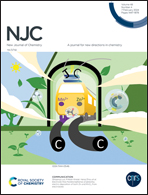Click chemistry-based synthesis of new 1,2,3-triazolo-benzoquinoline-3-carbonitriles: anticancer screening and DFT studies†
Abstract
This study emphasizes the synthesis of a novel series of 1,2,3-triazolo-benzoquinoline-3-carbonitriles by using Cu(I)-catalyzed azide–alkyne cycloaddition known as the click reaction. The reaction of novel acetylenic aryl-benzoquinoline-3-carbonitriles 7–12 with 1-azido-2,5-dimethoxy-4-nitrobenzene 13 afforded the corresponding 1,2,3-triazolo-benzoquinoline-3-carbonitriles 14–19 in good yields. The desired products were examined against different tumor cells such as the human colon (HCT-116), hepatocellular carcinoma (HepG2), human breast adenocarcinoma (MCF-7) and one human healthy cell line (BJ-1) using the LDH assay. Generally, the five compounds (11, 10, 9, 12 and 15, respectively) can be considered good colon anticancer drug candidates as their cytotoxic activities on the colon cancer cells are higher than their cytotoxic activities on the normal cells. In the case of HepG2 human liver cancer cells, compounds 16, 12 and 9 have more potent cytotoxic activities relative to doxorubicin as the standard reference. Supporting the experimental antiproliferative IC50 of the compounds tested against the cancer cell line, the molecular electrostatic potential (MEP) distribution and frontier molecular orbitals (FMOs) of all compounds have been calculated in the ground state theoretically by the DFT/B3LYP method using the 6-31G(d) basis set. Compounds 10, 15 and 19 showed a chemical softness value of 14.59 eV−1 higher than those of all of the compounds. The highest values of the electrophilicity index were observed in compounds 17, 10, 16 and 15.



 Please wait while we load your content...
Please wait while we load your content...